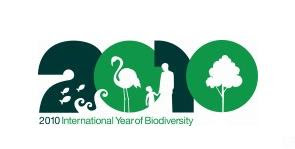2010 - International Year of Biodiversity. From [2].
2010 was declared as the International Year of Biodiversity by the United Nation's General Assembly. Although initial celebrations began in November under the slogan “Biodiversity is life, biodiversity is our life,” the official launch will take place in Berlin tomorrow, on 11 January, 2010.
The purpose of this declaration was to to bringing greater international attention to the continued loss of biodiversity and to increase awareness of the importance of biodiversity by promoting actions at the local, regional and international levels.[1]
Below I quote textually from the UN website.[2]
Take Action in 2010!
Biodiversity is life
Biodiversity is our life
Participate
Be inspired and get involved! It is the actions of individuals that will ultimately make a difference for safeguarding biodiversity.
Learn
» About biodiversity in your city, region and country
» How your consumption patterns and everyday actions may impact on biodiversity, sometimes in distant ecosystems
Speak
»Make your views known to the government and the private sector
»Share your knowledge with people around you
»Send us your Success stories so we can share them with the rest of the world
Act
»Make responsible consumption choices
»Support activities and organizations that conserve biodiversity
»Join a local environmental NGO or organize your own activities that will help biodiversity
»Be creative and find solutions to biodiversity loss
»Send us your pictures, artwork, videos and other creations, and we'll share them with the world
So, it sounds quite interesting, but what does this have to do with cryptozoology? or Patagonia?
Cryptozoology
Cryptozoology is all about biodiversity: its subject is scarce (endangered), or possibly extinct cryptids. We should be concerned about this critical subject and do something about it.
Patagonia
This unique place is also under threat. Climate change, logging and mining, overfishing, whale killing, sheep farming, oil extraction,reckless tourism, dams and utility plants built to produce electricity used elsewhere have a negative impact on the fragile Patagonian ecosystem. The steppe and the forests harbor endemic species (unique to the Patagonian region) which must be protected.
Taking Action
What can WE do about it?
1. Improve our impact on the Patagonian ecosystems
Tourists (whether the average nature loving person or a cryptozoolgist investigating on site) often visit wild and "untouched" natural places. As responsible global citizens, when outdoors we should not harm the environment.
We should leave no trace and tread lightly, in other words, when we are enjoying the outdoors we must minimize our impact on the environment.
Some smart tips on what to do (and what not) when outdoors can be found at the following websites of two NGOs: Leave no Trace and Tread Lightly [3][4]:
2. Learn more about Biodiversity
Below is a cool informative website on Argentina's living species, biodiversity and our National Parks (it includes Patagonia):

Sistema de Información de Biodiversidad. Argentine National Parks Administration.
I will keep on posting on "Biodiversity" and what we can do to reduce our impact on the environment:
» Climate Change.
Bibliography.
[1] UN years and decades
[2] International Year of Biodiversity official website
[3] Tread Lightly
[4] Leave no Trace
Copyright 2009-2010 by Austin Whittall ©
Patagonian Monsters Cryptozoology, Myths & legends in Patagonia



















it is a nice marimonial
ReplyDelete